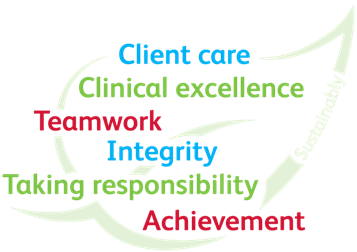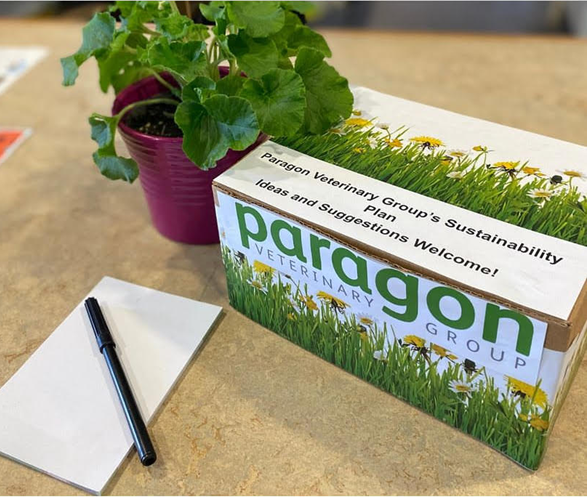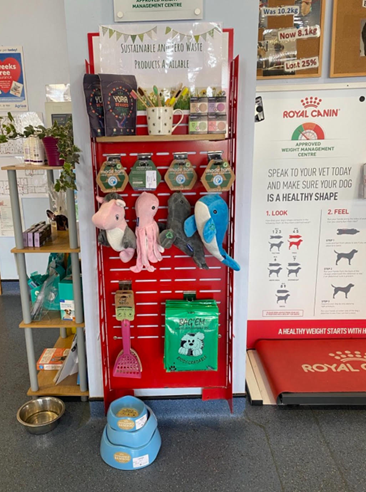
Effective client communication is something most vet professionals must navigate and strive for most days. Now, we’re adding sustainability and “carbon pawprints” into the conversation and expecting everyone to just “get on with it”. But this can be really challenging: there are so many nuances to consider that allow the vet professional to impart effective communication and ensure client understanding. Also, we are aware that clients only take in a fraction of what is discussed in our interactions, so our time, actions and words are precious. We need to use them wisely.
This article aims to provide you with some tried and tested tips on how to effectively communicate with your clients, from my small animal perspective in the slightly mind-boggling world of veterinary sustainability.
How can I embed sustainability values in practice?
Effective communication starts within the core of the practice, with both the clinical and non-clinical support teams, and is underpinned by how you integrate sustainability into practice beliefs and culture. Once this is established, ensuring conversations include a sustainability angle will become second nature.
Make sustainability visible

Emphasise your practice’s sustainability values by making them visible to staff and clients around the practice. We added “sustainability” to our practice values at Paragon Veterinary Group not as a stand-alone value, but as a theme that is at the heart of our culture and all of our business operations. These are displayed on walls in our offices and waiting areas, as a backdrop for a lot of our social media posts, and on our website and intranet as a reminder to us all. They are clear and self-explanatory, which adds to their impact (Figure 1).
Having your values so visible sends out a positive, subconscious message to your clients, reinforcing your commitment to being a sustainable business and that green issues matter to you. It’s likely your new clients have chosen your practice because of it, so it’s beneficial to reiterate this to them, which in turn strengthens their loyalty and resolve for choosing to join you. In turn, they’ll expect you to have conversations about the environment and how you and they can reduce their impact. Be open to feedback and act on it (Figure 2).
Having your values so visible sends out a positive, subconscious message to your clients, reinforcing your commitment to being a sustainable business and that green issues matter to you

Build confidence in discussing sustainability
Staff education and training are key to gaining understanding and developing confidence to have these conversations and, in turn, to effectively communicate with our clients
To start these conversations on sustainability, begin with the why, then the how and what. Staff education and training are key to gaining understanding and developing confidence to have these conversations and, in turn, to effectively communicate with our clients. Vet Sustain runs veterinary-specific carbon literacy training for everyone in the profession; it provides a great framework and understanding of the challenges we face and equips the learner with the solutions. For those members of the practice team wanting a deeper dive into the understanding of our profession’s impact and what we can do about it, Vet Sustain also provides “A sustainable approach to clinical veterinary practice” CPD course.
It all counts

Effective communication comes in many guises: from the moment our clients walk into the practice, positive messaging on the walls, posters and reels running on the waiting room TV, newsletters and pet pawprint guides, face-to-face and virtual consultations with a vet and RVN, from your front of house team, what you stock (and don’t stock) in your waiting rooms (Figure 3), from the webinars and podcasts you are involved in, social media posts and local news stories, community projects and events you get involved in, blister pack recycling service, awards (eg investors in the environment, RCVS PSS Environmental Sustainability award) you’ve worked so hard to achieve. Incentivise clients not to drive to their appointments. Oldhall Vets incentivises their clients by planting a tree every time they walk or cycle to their appointment.
Advise on preventative medicine
Preventative medicine is one of the most effective ways to reduce a pet’s carbon pawprint, and save your clients money. Healthy pets don’t require as many trips to the vets, medications or GAs, and they consume less. Your vet and RVN teams can have climate-positive conversations about firstly how to choose a pet – from species, breed, size and adoption – to more in-depth discussions around what to feed them, neutering, the importance of poo picking, how to reduce your pet’s impact on biodiversity, why healthy weight management is important, preventative dental care at home, the importance of vaccination and appropriate use of antibiotics and parasiticides. Each of these conversations has multiple opportunities to provide our clients with information on maintaining patient health, saving money and reducing environmental impact.
Preventative medicine is one of the most effective ways to reduce a pet’s carbon pawprint, and save your clients money
A trusted profession such as ours needs to uphold our code of conduct, whereby we are considering the impact of our actions on the environment while maintaining the highest standards of animal health and welfare.
Veterinary surgeons must seek to ensure the protection of public health and animal health and welfare, and must consider the impact of their actions on the environment
RCVS Code of Professional Conduct for Veterinary Surgeons
Communicating change can be challenging. A great example for this is the shift away from blanket parasiticide treatment towards a more risk-based approach. Explain to your clients that you are making this change in light of new research, understanding our responsibility to protect from harm not only their pets but the environment too. The outcome of acceptance will depend on how this is delivered: start with the why, then the how and what. Further reading and understanding on this topic can be found here. Vet Sustain has a lot of excellent resources and webinars on this and a wide range of sustainability-related topics.
Move to digital communications
Adopting the use of digital communications (eg email, online forms, video calls and digital messaging apps) will help reiterate and demonstrate your green messaging that reducing paper waste is something that is important to you. Moving to digital communications as your default will hugely reduce your impact on the planet, carbon footprint, time and costs: it’s a win-win-win! You will reduce carbon emissions from unnecessary journeys by doing some of your more routine follow-ups virtually.
Digital communication can help you reinforce your antimicrobial resistance (AMR) resolution too, with strategies such as automatic messaging sent 48 hours after antibiotics are dispensed to check your clients are managing to administer them. A further message can be sent 10 to 14 days later to check they’ve completed the course and ask that if there are any spare, they be returned for appropriate disposal. This will reduce the risk that any extra antibiotics will be kept for later inappropriate use and will ensure they aren’t flushed or end up in landfill, accelerating AMR. It also improves compliance. B Corp-accredited Pennard Vets does this as a matter of course.
Final thoughts
It’s worth remembering that at each and every point of contact we have the opportunity to be championing good environmental practice
It’s worth remembering that at each and every point of contact we have the opportunity to be championing good environmental practice. This drip, drip, drip messaging helps to embed sustainability into your values and ensures you’re known for it. Eventually, we’ll reach the tipping point where this becomes the norm, where you take every opportunity for sustainable quality improvement and there is an expectation from your staff and clients that you will behave in an environmentally sustainable way.
Lead by example: demonstrate green practices in all your interactions, which in turn will reinforce your commitment to the environment. Advocate for lowering our profession’s impact and be part of something we can all be proud of.







